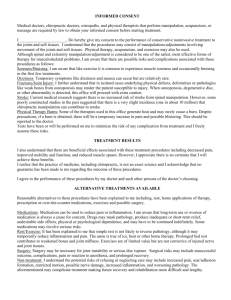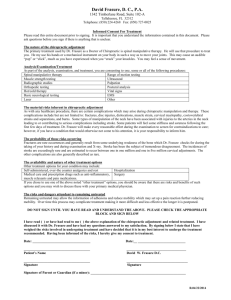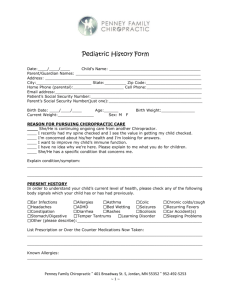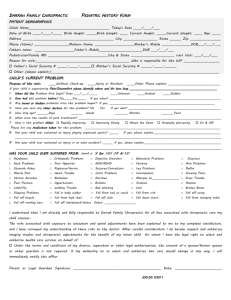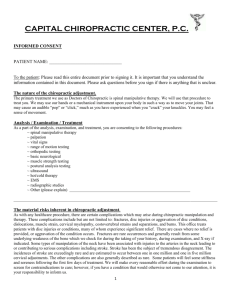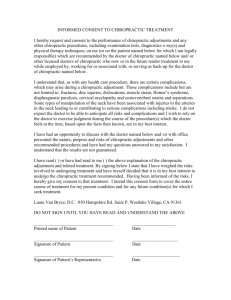Chiropractic--A safe treatment option
advertisement
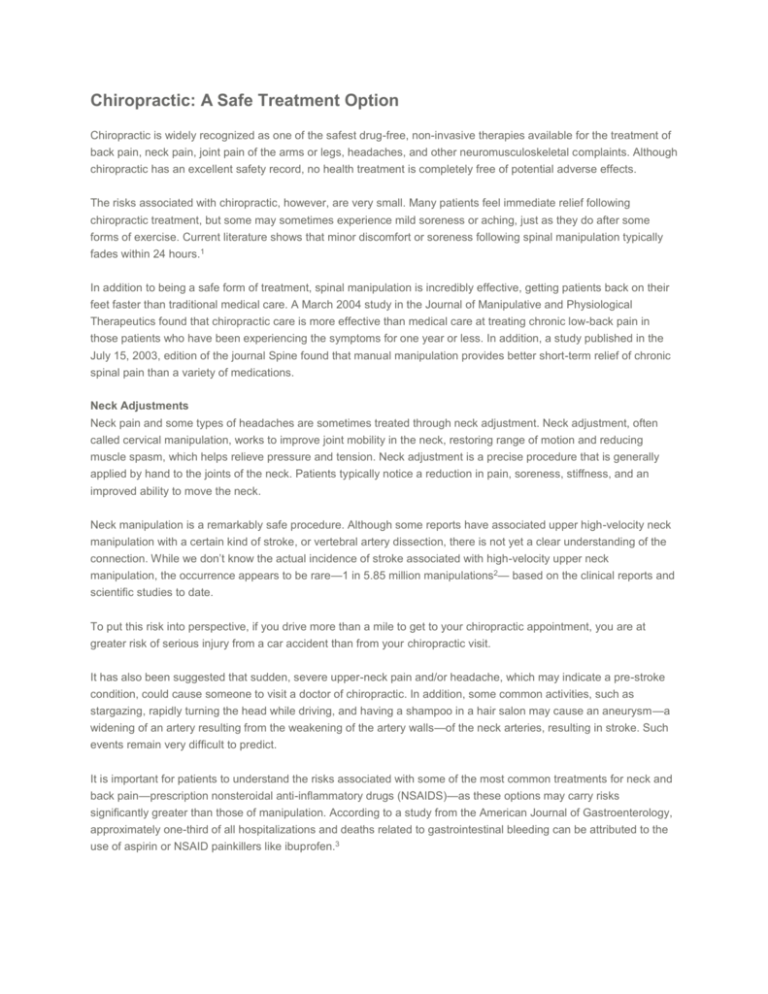
Chiropractic: A Safe Treatment Option Chiropractic is widely recognized as one of the safest drug-free, non-invasive therapies available for the treatment of back pain, neck pain, joint pain of the arms or legs, headaches, and other neuromusculoskeletal complaints. Although chiropractic has an excellent safety record, no health treatment is completely free of potential adverse effects. The risks associated with chiropractic, however, are very small. Many patients feel immediate relief following chiropractic treatment, but some may sometimes experience mild soreness or aching, just as they do after some forms of exercise. Current literature shows that minor discomfort or soreness following spinal manipulation typically fades within 24 hours.1 In addition to being a safe form of treatment, spinal manipulation is incredibly effective, getting patients back on their feet faster than traditional medical care. A March 2004 study in the Journal of Manipulative and Physiological Therapeutics found that chiropractic care is more effective than medical care at treating chronic low-back pain in those patients who have been experiencing the symptoms for one year or less. In addition, a study published in the July 15, 2003, edition of the journal Spine found that manual manipulation provides better short-term relief of chronic spinal pain than a variety of medications. Neck Adjustments Neck pain and some types of headaches are sometimes treated through neck adjustment. Neck adjustment, often called cervical manipulation, works to improve joint mobility in the neck, restoring range of motion and reducing muscle spasm, which helps relieve pressure and tension. Neck adjustment is a precise procedure that is generally applied by hand to the joints of the neck. Patients typically notice a reduction in pain, soreness, stiffness, and an improved ability to move the neck. Neck manipulation is a remarkably safe procedure. Although some reports have associated upper high-velocity neck manipulation with a certain kind of stroke, or vertebral artery dissection, there is not yet a clear understanding of the connection. While we don’t know the actual incidence of stroke associated with high-velocity upper neck manipulation, the occurrence appears to be rare—1 in 5.85 million manipulations2— based on the clinical reports and scientific studies to date. To put this risk into perspective, if you drive more than a mile to get to your chiropractic appointment, you are at greater risk of serious injury from a car accident than from your chiropractic visit. It has also been suggested that sudden, severe upper-neck pain and/or headache, which may indicate a pre-stroke condition, could cause someone to visit a doctor of chiropractic. In addition, some common activities, such as stargazing, rapidly turning the head while driving, and having a shampoo in a hair salon may cause an aneurysm—a widening of an artery resulting from the weakening of the artery walls—of the neck arteries, resulting in stroke. Such events remain very difficult to predict. It is important for patients to understand the risks associated with some of the most common treatments for neck and back pain—prescription nonsteroidal anti-inflammatory drugs (NSAIDS)—as these options may carry risks significantly greater than those of manipulation. According to a study from the American Journal of Gastroenterology, approximately one-third of all hospitalizations and deaths related to gastrointestinal bleeding can be attributed to the use of aspirin or NSAID painkillers like ibuprofen.3 Furthermore, surgery for conditions for which manipulation may also be used carries risks many times greater than those of chiropractic treatment. Even prolonged bed rest carries some risks, including muscle atrophy, cardiopulmonary deconditioning, bone mineral loss and thromoembolism.4 If you are visiting your doctor of chiropractic with upper-neck pain or headache, be very specific about your symptoms. This will help your doctor of chiropractic offer the safest and most effective treatment, even if it involves referral to another health care provider. If the issue of stroke concerns you, do not hesitate to discuss it with your doctor of chiropractic. Depending on your clinical condition, he or she can forego manipulation, and instead can recommend joint mobilization, therapeutic exercise, soft-tissue techniques, or other therapies. Research Ongoing The ACA believes that patients have the right to know about the health risks associated with any type of treatment, including chiropractic. Today, chiropractic researchers are involved in studying the benefits and risks of spinal adjustment in the treatment of neck and back pain through clinical trials, literature reviews and publishing papers reviewing the risks and complications of neck adjustment. All available evidence demonstrates that chiropractic treatment holds an extremely small risk. The chiropractic profession takes this issue very seriously and engages in training and postgraduate education courses to recognize the risk factors in patients, and to continue rendering treatment in the most effective and responsible manner. References 1. Senstad O, et al. Frequency and characteristics of side effects of spinal manipulative therapy. Spine 1997 Feb 15;435-440. 2. Haldeman S, et al. Arterial dissection following cervical manipulation: a chiropractic experience. Can Med Assoc J 2001;165(7):905-06. 3. Lanas A, et al. A nationwide study of mortality associated with hospital admission due to severe gastrointestinal events and those associated with nonsteroidal anti-inflammatory drug use. Am J Gastroenterol 2005;100:1685–1693. 4. Lauretti W. The Comparative Safety of Chiropractic. In Daniel Redwood, ed., Contemporary Chiropractic. New York: Churchill Livingstone, 1997, p. 230-8.
